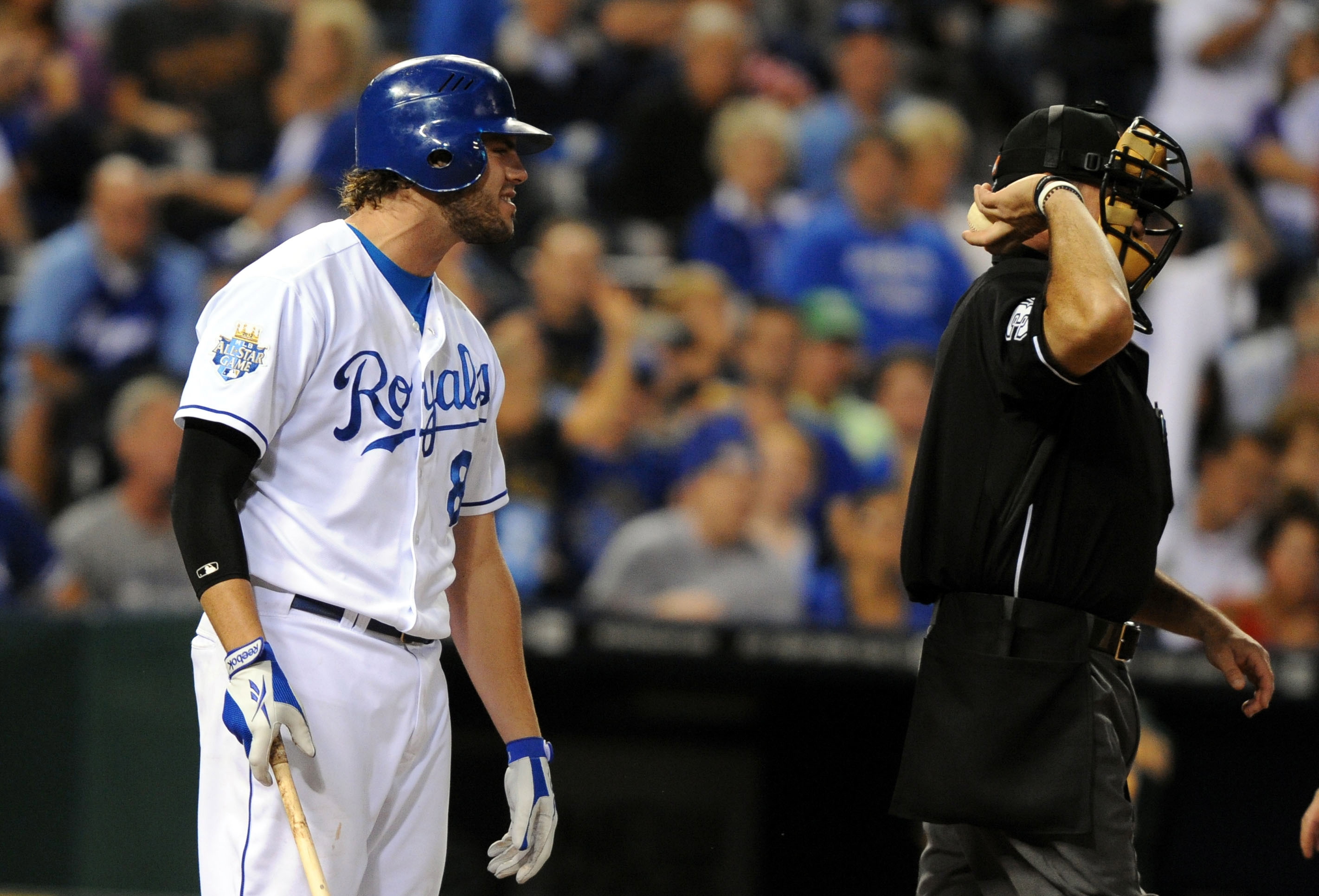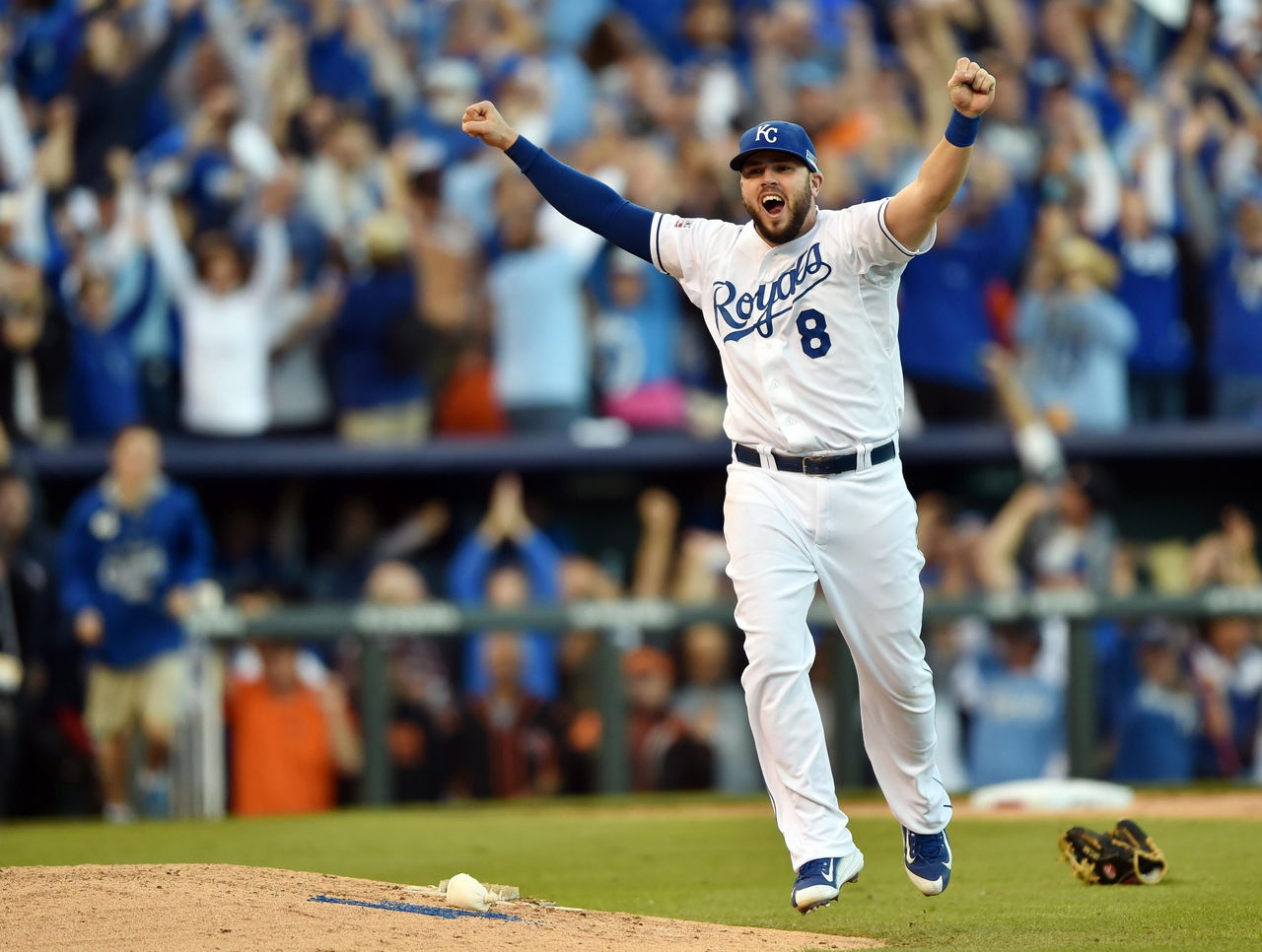Bacardi Untameable - Mike Moustakas finds his place in Royals' frenetic playoff run

Mike Moustakas's career has been defined by numbers.
No. 2 pick. Eighty-four minor-league homers. Baseball America's ninth-ranked prospect.
He went deep 46 times in 173 Double- and Triple-A games, slugging his way to a quick promotion in 2011. By 2012, the 23-year-old Moustakas already had a 20-homer campaign under his belt.
The digits on the back of his baseball card staked Moustakas to an early reputation as one of the game's most promising talents.
And then those numbers betrayed him, nose-diving like a 90-mph slider barreling in on his left-handed bat. Moustakas wasn't developing, he was regressing, and he wasn't even eight months into his major-league career.
"It's a crazy game," Moustakas said back in September 2012, trying to explain his struggles on the road during his first full season in the majors. "There's numbers for everything, and there's a lot of stuff that we can't explain as players."

The slick-fielding third baseman ended that year hitting .204 over the final month of the season, and so began the end of his big-league honeymoon.
Down went his AVG, OBP, OPS and every other acronym that had been so kind to him during his life on the diamond. Moustakas had crushed pitching at nearly every level he had played, and here he was stuck in neutral on the fast-moving highway of unreasonable expectations.
To borrow a phrase from Kansas City Star writer Rustin Dodd: Moustakas looked like a broken prospect.
Subsequent springs represented opportunities for change; a chance to piece together his fractured psyche and cash in on the promise that had him drafted ahead of Matt Wieters, Madison Bumgarner and Jason Heyward.
But once the calendar turned to April, Moustakas was back trying to hit himself out of quicksand. He battled to keep his declining average and on-base percentage from delving further into the abyss.
Royals manager Ned Yost spoke to Newsday during the 2014 playoffs about how Moustakas's internal struggles manifested into a poor approach at the plate:
(The) last two springs he was the best player in baseball. He'd go through the entire spring with 35 RBIs, and hitting home runs off left and righthanders, and start pressing from the get-go at the start of the season.
In typical Moustakas fashion, he flirted with success during a two-month stretch last summer. The California native posted a robust .301/.347/.479 (126 wRC+) slash line across 176 plate appearances from June 18 to Aug. 17.
A small sample, but perhaps it was just enough to uncover the confidence that eluded him his first three seasons in the league.
"All the work with (Royals hitting coaches) George (Brett) and Pedro (Grifol) is starting to pay off," Moustakas told MLB.com after clubbing a go-ahead homer during a 6-5 win over Detroit last July. "I feel a lot more comfortable at the plate and I feel like my swing is coming around to where it needs to be."
But Moustakas countered his step forward with two leaps back, hitting .223 with a pair of homers over the final 32 games of the season. Off to Venezuela he went for winter ball, once again in search of his swing, confidence and perhaps career.
Hope springs eternal
Kansas City entered the 2014 season brimming with optimism, but by the middle of May the Royals and Moustakas found themselves in familiar waters.
The club was 23-23 and struggling to stay afloat in the AL Central, while Moustakas's numbers were again plummeting into futility.
On May 21, the Royals had seen enough. Moustakas, batting .152, was sent down to Triple-A Omaha.
"He looked lost, and that's where it got to him," Yost said. "The last day that he played, you could just tell that his confidence was suffering and he was just putting too much pressure on himself."
Advanced statistics suggested some luck was involved in his struggles. Dave Cameron of FanGraphs pointed out that at the time of his demotion Moustakas had the lowest batting average on balls in play (.155) in the majors (of players with at least 130 plate appearances). Cameron isolated the probable cause for such a low BABIP: lack of discipline.
He’s hitting the wrong pitches. For the season, Moustakas has made contact on 82.4% of the pitches he’s swung at outside the strike zone - the fifth highest rate in MLB - while only making contact on 81.4% of the pitches he’s swung at inside the strike zone. Moustakas is the only player in MLB to post a higher contact rate on balls as opposed to strikes.
Moustakas, fixated on his diminished stat line, was doubling down by swinging at pitches he shouldn't have, and generating weak contact as a result. His intentions were well placed - his approach was not.
No more than 10 days later, Moustakas was back in the majors after destroying Triple-A pitching. The Royals hoped a crooked slash line was all he needed to rediscover his confidence at the plate, just like teammates Billy Butler and Alex Gordon had done during their developing years.
But whatever rhythm Moustakas found in Omaha, he left it there.
Although he continued to provide exceptional defense, and finished the year with the best walk rate of his career, he was still making outs at an unacceptable rate. Moustakas hit .235, slugged .377 and created 13 percent fewer runs than the league average following his promotion.
After clubbing five homers in July, he hit just one over his last 49 games.
The Royals, meanwhile, took off in the second half, going 34-21 in August and September to clinch the playoffs for the first time since 1985.
Moustakas's frustrating year came to a close with an exhausting 10-pitch at-bat during the Royals' final game of the season. It was a microcosm of his career: he fought, showed signs of life, but in the end, struck out.
The season was finally over and the Royals were headed to the playoffs. Moustakas was thrilled to leave his .212 batting average behind.
Hitting the reset button
If the spring was filled with hope, the fall represented a shot at redemption.
The prospect of playing meaningful baseball in October allowed Moustakas the chance for a reboot - an opportunity to get back to the fundamentals of the game.
Said Yost: "His focus was, I'm going to do whatever I need to do to win, and all of a sudden once the playoffs started it's not about the average anymore, all it's about is winning a baseball game."
And just like that, a postseason legend was born.

Moustakas walked the Royals off to victory in Game 1 of the AL Division Series against the Los Angeles Angels with a dramatic solo shot in the 11th, and would go deep again in their series-clinching Game 3 win.
He continued his power surge into the AL Championship Series, connecting for a two-run shot in the 10th inning of Game 1 against Baltimore before breaking a 3-3 tie in Game 2 with his franchise-record-matching fourth homer of the playoffs.
"All that other stuff that happened this year is over with," Moustakas told USA TODAY Sports during the ALCS. "It's done. Nothing I can do to change it. No need to sit back and look at how good of a season or how bad of a season you had."
Moustakas hasn't missed a beat in the field, either, making a pair of outstanding catches in Game 3 of the ALCS, including the signature play of the playoffs so far.
(Courtesy: MLB.com)
Moustakas carries a healthy .922 postseason OPS and playoff-leading four homers into the World Series. Ironically, numbers continue to define his play. The difference, however, is they're not his source of motivation.
"It's freed him up to come out and play his game as well as he's played," Yost said during the ALCS. "He's willing to do anything that he can to help this team win. And his average or his anything (else) doesn't come into play. It's all about his team."
Unchained from the shackles of individual pressure, Mike Moustakas is back to playing baseball again. And what a terrific brand of ball it's been.
HEADLINES
- Nats' López sorry for pitch over McCutchen's head before benches cleared
- Braves' Strider has message for doubters: 'Bring it on'
- Pirates baseball: Three rivers of fan angst and animosity
- MLB Roundtable: Early standouts, storylines emerge
- Umpire Wendelstedt goes to hospital after taking foul ball off head